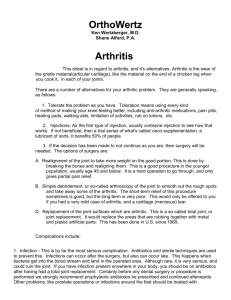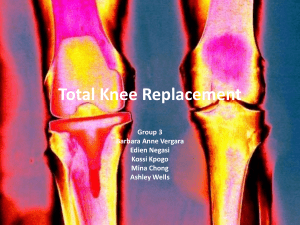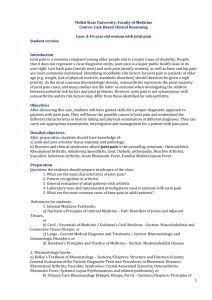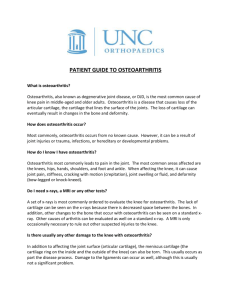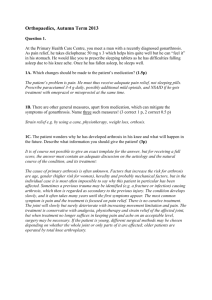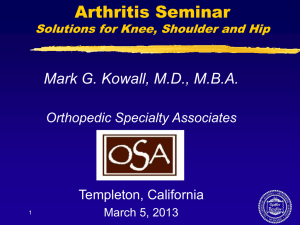Information on Knee Arthritis
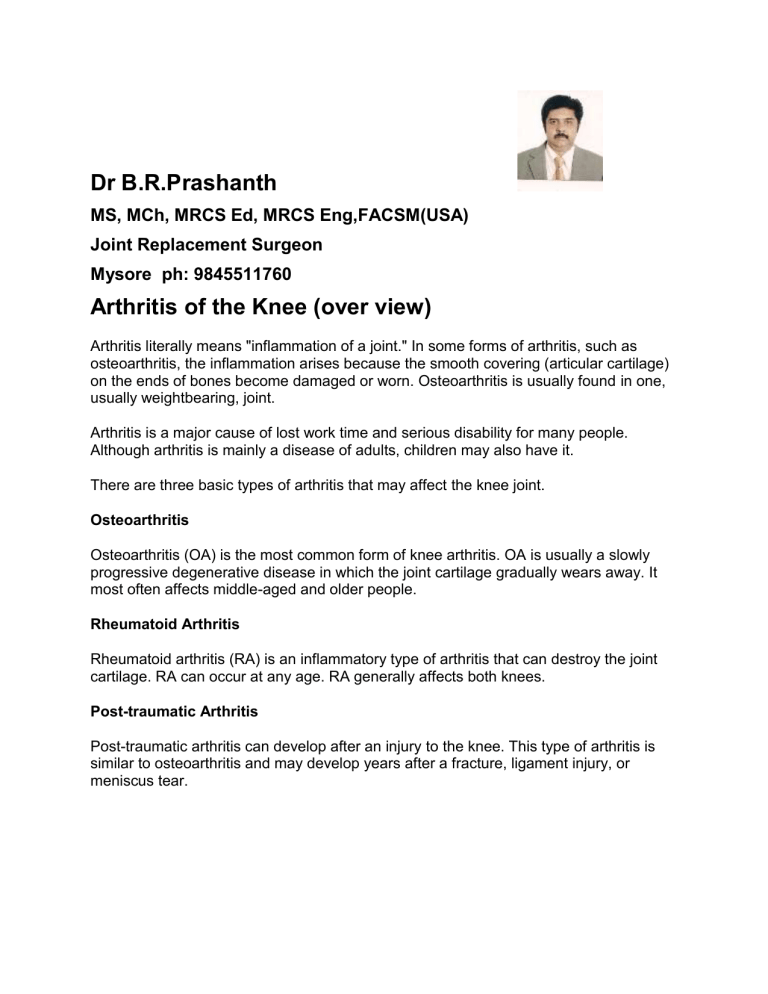
Dr B.R.Prashanth
MS, MCh, MRCS Ed, MRCS Eng,FACSM(USA)
Joint Replacement Surgeon
Mysore ph: 9845511760
Arthritis of the Knee (over view)
Arthritis literally means "inflammation of a joint." In some forms of arthritis, such as osteoarthritis, the inflammation arises because the smooth covering (articular cartilage) on the ends of bones become damaged or worn. Osteoarthritis is usually found in one, usually weightbearing, joint.
Arthritis is a major cause of lost work time and serious disability for many people.
Although arthritis is mainly a disease of adults, children may also have it.
There are three basic types of arthritis that may affect the knee joint.
Osteoarthritis
Osteoarthritis (OA) is the most common form of knee arthritis. OA is usually a slowly progressive degenerative disease in which the joint cartilage gradually wears away. It most often affects middle-aged and older people.
Rheumatoid Arthritis
Rheumatoid arthritis (RA) is an inflammatory type of arthritis that can destroy the joint cartilage. RA can occur at any age. RA generally affects both knees.
Post-traumatic Arthritis
Post-traumatic arthritis can develop after an injury to the knee. This type of arthritis is similar to osteoarthritis and may develop years after a fracture, ligament injury, or meniscus tear.
An osteoarthritic knee (damaged cartilage)
A healthy knee
Symptoms:
Generally, the pain associated with arthritis develops gradually, although sudden onset is also possible. The joint may become stiff and swollen, making it difficult to bend or straighten the knee.Pain and swelling are worse in the morning or after a period of inactivity. Pain may also increase after activities such as walking, stair climbing, or kneeling.The pain may often cause a feeling of weakness in the knee, resulting in a
"locking" or "buckling."Many people report that changes in the weather also affect the degree of pain from arthritis
.
Your Orthopaedic Surgeon will perform a physical examination that focuses on your walk, the range of motion in the limb, and joint swelling or tenderness.
X-rays typically show a loss of joint space in the affected knee. Blood and other special imaging tests, may be needed to diagnose rheumatoid arthritis.
Normal joint space between the femur and tibia. Decreased joint space due to damaged cartilage and bone spurs.
Nonsurgical Treatment
If you have osteoarthritis of the knee, you can take advantage of a wide range of treatment options. The effectiveness of different treatments varies from person to person. The choice of treatment should be a joint decision between you and your
Surgeon. The purpose of treatment is to reduce pain, increase function and generally reduce your symptoms.
In its early stages, arthritis of the knee is treated with nonsurgical measures.
Nonsurgical treatments fall into four major groups: lifestyle modifications; exercise; supportive devices; other methods.
Lifestyle Modification
Lifestyle modifications include losing weight and minimizing activities that aggravate the condition, such as climbing stairs. Many, but not all, people with osteoarthritis of the knee are overweight. Simple weight loss can reduce stress on weight bearing joints, such as the knee. Losing weight can result in reduced pain and increased function, particularly in walking.
Exercise
Exercises can help increase range of motion and flexibility as well as help strengthen the muscles in the leg. Physical therapy and exercise are often effective in reducing pain and improving function.
Supportive Devices
Using supportive devices, such as a cane, wearing energy-absorbing shoes or inserts, or wearing a brace can be helpful. They may be especially helpful if the arthritis is centered on one side of the knee. A brace can assist with stability and function. There are two types of braces that are often used. An "unloader" brace shifts load away from the affected portion of the knee. A "support" brace helps support the entire knee load.
Your Surgeon will decide the appropriate brace for you.
Other Methods
Other measures may include applications of heat or ice, water exercises (hydrotherapy), liniments or elastic bandages.
Medications
Several types of medications can be used in treating arthritis of the knee. Because every patient is different, and because not all people respond the same to medications, your orthopaedic surgeon will prescribe the medications for your specific condition.
Anti-inflammatory medications help reduce swelling in the joint. Simple pain relievers such as paracetamol are and can be very effective in reducing pain. Pain relievers are usually the first choice of therapy for osteoarthritis of the knee. All medications have potential side effects and simple analgesics are no exception. It is important to realize that these medications, can also interact with other medications you are taking, such as blood-thinners. Be sure to discuss these issues with your Orthopaedic Surgeon.
A more potent type of pain reliever is a nonsteroidal anti-inflammatory drug or NSAID.
Like all pain relievers, NSAIDs can cause side effects including changes in kidney and liver function as well as a reduction in the ability of blood to clot. These effects are usually reversible when the medication is discontinued.
Glucosamine and Chondroitin
Glucosamine and chondroitin (kon-dro'-i-tin) sulfate are oral supplements may relieve the pain of osteoarthritis. These are two large molecules that are found in the cartilage of our joints. Glucosamine and/or chondroitin sulfate may be particularly helpful in the early stages of osteoarthritis of the knee, provided they are used as directed on package inserts and with caution. Although glucosamine and chondroitin sulfate are natural substances, sometimes classified as food additives, they can cause side effects such as headaches, stomach upset, nausea, vomiting, and skin reactions. These supplements can interact with other medications.
Corticosteroids
Corticosteroids are powerful anti-inflammatory agents that can be injected into the joint.They are given for moderate to severe pain. They can be very useful if there is significant swelling, but are not very helpful if the arthritis affects the joint mechanics.
They can provide pain relief and reduce inflammation with a subsequent increase in quadriceps (thigh muscle) strength. However, the effects are not long-lasting, and no more than four injections should be given per joint per year. In addition, there is some concern about the use of these injections. For example, pain and swelling may "flare" immediately after the injection, and the potential exists for long-term joint damage or infection. With frequent repeated injections or over an extended period of time, joint damage can actually increase rather than decrease.
Viscosupplementation with Hyaluronic Acid
A relatively new procedure, called viscosupplementation, injects a preparation of hyaluronic acid into the knee joint. Hyaluronic acid is a naturally occurring substance found in the synovial (joint) fluid. It acts as a lubricant to enable bones to move smoothly over each other and as a shock absorber for joint loads.
People with osteoarthritis ("wear-and-tear" arthritis) have a lower-than-normal concentration of hyaluronic acid in their joints. Viscosupplementation may be a therapeutic option for individuals with osteoarthritis of the knee.
Hyaluronic acid does seem to have anti-inflammatory and pain-relieving properties. The injections may also stimulate the body to produce more of its own hyaluronic acid.
Effects may last for several months. This option can be discussed with your
Orthopaedic Surgeon.
Alternative Therapies
Alternative therapies include the use of acupuncture and magnetic pulse therapy. Many forms of therapy are unproven, but reasonable to try, provided you find a qualified practitioner and keep your Surgeon informed of your decisions.
Acupuncture uses fine needles to stimulate specific body areas to relieve pain or temporarily numb an area. Although it is used in many parts of the world and evidence suggests that it can help ease the pain of arthritis, there are few scientific studies of its effectiveness.
Magnetic pulse therapy is painless and works by applying a pulsed signal to the knee, which is placed in an electromagnetic field. Like many alternative therapies, magnetic pulse therapy has yet to be proven.
Surgical Treatment
If your arthritis does not respond to these nonsurgical treatments, you may need to have surgery.
There are a number of surgical options, including the following:
Arthroscopic surgery uses fiber optic technology to enable the surgeon to see inside the joint and clean it of debris or repair torn cartilage.
An osteotomy cuts the shinbone (tibia) or the thighbone (femur) to improve the alignment of the knee joint.
A total or partial knee arthroplasty replaces the severely damaged knee joint
cartilage with metal and plastic.
Cartilage grafting is possible for some knees with limited or contained cartilage loss from trauma or arthritis.

